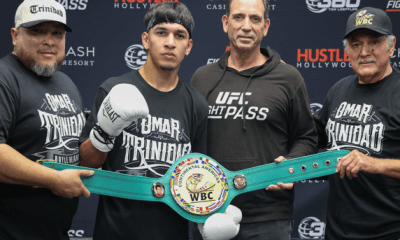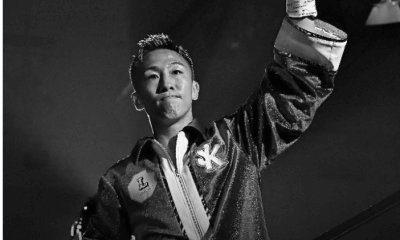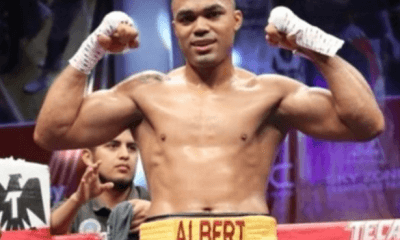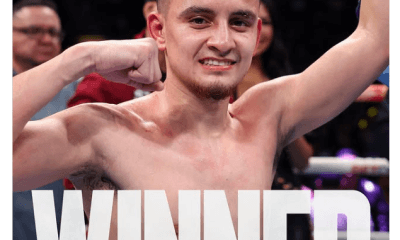Featured Articles
R.I.P. Former Heavyweight Contender “Smokin’” Bert Cooper, Dead at 53
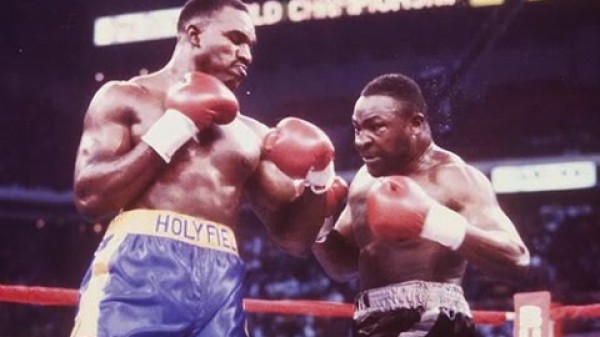
“Smokin’” Bert Cooper, the Joe Frazier lookalike who patterned his own boxing style after that of his idol, mentor and former manager, was 53 when he lost his battle with pancreatic cancer on Friday. Best-known for his knockdown of IBF/WBA heavyweight champion Evander Holyfield in their title bout in Holyfield’s hometown of Atlanta, Cooper, a 32-to-1 underdog from the Philadelphia suburb of Sharon Hill, Pa., might have pulled off the biggest upset since Buster Douglas’ shocker over Mike Tyson when, in the third round of the Nov. 23, 1991, bout at The Omni, he landed an explosive overhand right to the titlist’s jaw.
Holyfield stumbled backward into the ropes as Cooper rushed forward to follow up with a barrage of punches. A clearly buzzed Holyfield was sent sagging, his right knee brushing the canvas. Referee Mills Lane, having decided that Holyfield was being held up by the ropes, immediately jumped in, signaled a knockdown and gave him a standing-eight count.
“The Real Deal’s” undefeated record (he had come in 26-0 with 21 KOs) and championship reign might well have gone up in, well, smoke were it not for those few seconds of rest. When an overanxious Cooper rushed in again to seal the deal, Holyfield – whose recuperative powers were well-documented – answered with a barrage of his own that carried him to the end of the shakiest round of his professional career to that point.
“My heart started to go boom, boom, boom,” Cooper said when asked for his reaction to the sight of Holyfield in trouble. “I thought I was the heavyweight champion of the world. I said to myself, `Oh, boy, this is it.’”
Except that it wasn’t. With the bell ending the round, the window of opportunity closed for Cooper. Holyfield began to reassert control in the fourth round and, as the seventh round was nearing a close, he landed 25 unanswered punches. Lane wrapped his arms around the bloodied Cooper and waved the fight to a halt after an elapsed time of 2 minutes, 58 seconds. Former heavyweight champion George Foreman, a color analyst for HBO’s telecast, said the fight was “the best I’ve seen,” but he criticized Lane’s actions in both the third and seventh rounds.
“He saved Evander Holyfield (in the third round), yet, when he stopped the fight, he didn’t give the other guy a standing eight-count,” Foreman said. Lane said he couldn’t have given Cooper a standing eight-count in any case; IBF rules, under which the fight was held, did not allow for such. Holyfield was given an eight-count since he had been knocked down.
So, just how close had Holyfield come to relinquishing his titles to a man who was a substitute for a substitute, called off the scrap heap to replace the injured Francesco Damiani just a week before the bout? Damiani, for his part, was a substitute for Mike Tyson, who also had to withdraw with an injury that, coupled with his subsequent conviction for rape, would put him on ice for nearly four years.
It would be easy now for those who never saw Bert Cooper at his grittiest to dismiss him as just another journeyman who got a dream shot he didn’t really deserve, someone who should have counted himself fortunate to simply not to be embarrassed by a vastly superior champion. Cooper’s record would seem to support such an allegation: he retired after a sixth-round stoppage loss to Carl Davis on Sept. 8, 2012, with a 38-25 record, 31 of the victories coming inside the distance. He also lost by KO or TKO 16 times.
But even in his declining phase as a steppingstone, a guy with some residual name value to be added to the resume of champions or near-champions on their way down or young guns on the way up, Cooper always posed a threat to upset the applecart. Although he was just 11-17 in his final 28 fights, the first of which was another near-miss bid for a heavyweight title, in this instance the vacant WBO belt won by Michael Moorer in an Atlantic City slugfest in which each man went down twice, his setbacks at least came against some of the division’s brighter lights. In addition to Moorer, Cooper’s list of conquerors included Mike Weaver, Corrie Sanders, Larry Donald, Jeremy Williams, Alexander Zolkin, Chris Byrd, Samson Po’uha, Derrick Jefferson, Fres Oquendo, Joe Mesi and Luis Ortiz.
That he fought as long as he did, and as reasonably well, while struggling with the dual demons of drug and alcohol addictions makes his journey to the outer fringes of stardom as remarkable as it is sad. It was Cooper’s inability to hide his out-of-the-ring struggles from Joe Frazier that led to their breakup.
“Pop looked upon Bert almost as a member of the family,” Joe’s son, former heavyweight contender Marvis Frazier, recalled in November 1991. “He treated him better than he did me. Well, almost.”
It was the realization of Cooper’s drug use that was partly responsible for Joe Frazier quitting as his protégé’s manager after Cooper was stopped in seven rounds by Carl “The Truth” Williams for the vacant USBA heavyweight title on June 21, 1987, in Atlantic City. The 5-foot-11 Cooper, who previously had competed as a cruiserweight, claimed he had been forced to move up to heavyweight by Frazier, who had mandated the change because he wanted to relive his championship glory through Cooper.
“I realized (after the Williams fight) I’m not a heavyweight,” Cooper said. “I put on a lot of phony weight just eating sloppy stuff, junk food. Joe wanted me to be a heavyweight, just like he did with Marvis. Joe wants someone with a world title belt just like he had.”
To go public with a statement like that, Marvis said, committed a betrayal of trust in Joe’s eyes. Those in the inner circle knew better than to air dirty laundry in the media. And so, days after Cooper’s loss to Williams, Joe informed him that he no longer could serve as his manager. Joe’s daughter, Jacqui Frazier-Lyde, said the best thing Cooper could do for her father would be to drop the “Smokin’” nickname.
What might Cooper have become had he not fallen under the sway of drugs and booze? Or alienated himself from the man he so deeply admired and whose life story he so desperately wanted to replicate? Cooper was just 12 years old when he decided what he was going to be when he grew up: he would become a boxer, a world champion, the toughest of the tough.
So Cooper started making daily trips from his Sharon Hill home to North Philadelphia, where his hero and role model, Joe Frazier, was operating a gym. It was there that he would learn – about life, about the fight game – at the foot of the master. But Joe Frazier, who lived clean and fought hard, was a proponent of tough love. Those who accepted his affection would also have to accept his discipline, and there were rules Joe had set down that could never be broached. Cross the line and violators ran the risk of alienation.
When Damiani fell out shortly after Tyson, promoter Dan Duva did not have to go rummaging at the bottom of the proverbial barrel for someone to fight Holyfield. At 5-11 and a taut 211 pounds, Cooper not only was a physical prototype of Joe Frazier, but of Tyson, whom Holyfield had trained for in the first place.
“I guess all the work Evander put in getting ready for Tyson won’t go to waste now,” said George Benton, Holyfield’s trainer. “Fighting Cooper is a lot like fighting Tyson. They’re both short, strong guys who come straight at you and try to rough you up. They both have that kill-or-be-killed attitude.
“I don’t know if Cooper is the closest thing to Tyson, although he’s pretty damn close in some ways. But let’s be honest. In other ways they don’t really compare at all. Cooper doesn’t punch as fast or as hard as Tyson, and he doesn’t take a shot nearly as well. Tyson does a lot of smart things for a slugger. Cooper basically is a brawler. Tyson is the real thing. Cooper is not on the same level.”
But Cooper came ever so close to doing to Holyfield what Tyson – who, to be fair, was not at his snarling best following his incarceration – could not do in their two fights. It’s possible that Bert Cooper might have found the inner conviction he needed to pull himself together, had he won beaten Holyfield, and gone on to a Hall of Fame career more prestigious than his 2017 induction into the Pennsylvania Boxing HOF. It is also possible he would have flamed out in exactly the same manner than he eventually did. It is one of those questions that will always be left open to speculation.
Cooper entered the ring against Holyfield wearing a satin jacket with “The Smoke is No Joke” stitched across the back. At least that much is true. For all the intrigue and insults he so readily attracted, for a precious moment in time there was absolutely no one that was laughing at the supposedly no-chance challenger from just outside of Philadelphia.
Bernard Fernandez is the retired boxing writer for the Philadelphia Daily News. He is a five-term former president of the Boxing Writers Association of America, an inductee into the Pennsylvania, New Jersey and Atlantic City Boxing Halls of Fame and the recipient of the Nat Fleischer Award for Excellence in Boxing Journalism and the Barney Nagler Award for Long and Meritorious Service to Boxing.
Check out more boxing news on video at The Boxing Channel
To comment on this story in The Fight Forum CLICK HERE
-

 Featured Articles3 weeks ago
Featured Articles3 weeks agoThe Hauser Report: Zayas-Garcia, Pacquiao, Usyk, and the NYSAC
-

 Featured Articles2 weeks ago
Featured Articles2 weeks agoOscar Duarte and Regis Prograis Prevail on an Action-Packed Fight Card in Chicago
-

 Featured Articles1 week ago
Featured Articles1 week agoThe Hauser Report: Cinematic and Literary Notes
-

 Book Review3 days ago
Book Review3 days agoMark Kriegel’s New Book About Mike Tyson is a Must-Read
-

 Featured Articles4 weeks ago
Featured Articles4 weeks agoManny Pacquiao and Mario Barrios Fight to a Draw; Fundora stops Tim Tszyu
-

 Featured Articles3 weeks ago
Featured Articles3 weeks agoArne’s Almanac: Pacquiao-Barrios Redux
-

 Featured Articles2 weeks ago
Featured Articles2 weeks agoRemembering Dwight Muhammad Qawi (1953-2025) and his Triumphant Return to Prison
-
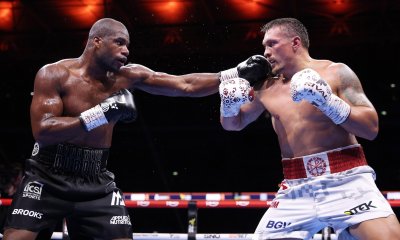
 Featured Articles4 weeks ago
Featured Articles4 weeks agoOleksandr Usyk Continues to Amaze; KOs Daniel Dubois in 5 One-Sided Rounds


